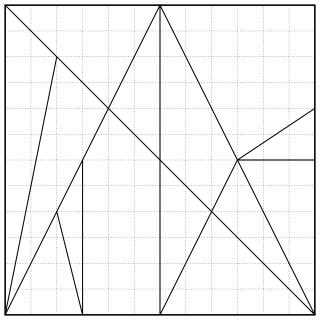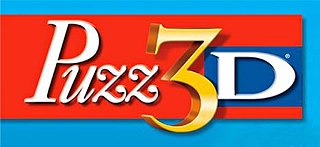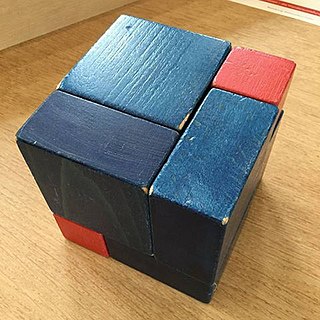 W
WIn geometry, a tetrad is four simply connected planar regions in the plane, each pair which share a finite portion of common boundary. It was named by Michael R. W. Buckley in 1975 in the Journal of Recreational Mathematics. A further question was proposed that became a puzzle, whether the 4 regions could be congruent, with or without holes, other enclosed regions.
 W
WTiling puzzles are puzzles involving two-dimensional packing problems in which a number of flat shapes have to be assembled into a larger given shape without overlaps. Some tiling puzzles ask you to dissect a given shape first and then rearrange the pieces into another shape. Other tiling puzzles ask you to dissect a given shape while fulfilling certain conditions. The two latter types of tiling puzzles are also called dissection puzzles.
 W
WThe Bedlam cube is a solid dissection puzzle invented by British puzzle expert Bruce Bedlam.
 W
WConway's puzzle, or blocks-in-a-box, is a packing problem using rectangular blocks, named after its inventor, mathematician John Conway. It calls for packing thirteen 1 × 2 × 4 blocks, one 2 × 2 × 2 block, one 1 × 2 × 2 block, and three 1 × 1 × 3 blocks into a 5 × 5 × 5 box.
 W
WThe diabolical cube is a three-dimensional dissection puzzle consisting of six polycubes that can be assembled together to form a single 3 × 3 × 3 cube. The six pieces are: one dicube, one tricube, one tetracube, one pentacube, one hexacube and one heptacube, that is, polycubes of 2, 3, 4, 5, 6 and 7 cubes.
 W
WIn geometry, a domino tiling of a region in the Euclidean plane is a tessellation of the region by dominos, shapes formed by the union of two unit squares meeting edge-to-edge. Equivalently, it is a perfect matching in the grid graph formed by placing a vertex at the center of each square of the region and connecting two vertices when they correspond to adjacent squares.
 W
WAn edge-matching puzzle is a type of tiling puzzle involving tiling an area with polygons whose edges are distinguished with colours or patterns, in such a way that the edges of adjacent tiles match.
 W
WThe Eternity II puzzle is an edge-matching puzzle launched on 28 July 2007. It was developed by Christopher Monckton and marketed and copyrighted by TOMY UK Ltd as a successor to the original Eternity puzzle. The puzzle was part of a competition in which a $2 million prize was offered for the first complete solution. The competition ended at noon on 31 December 2010, with no solution being found.
 W
WThe Eternity puzzle is a tiling puzzle created by Christopher Monckton and launched by the Ertl Company in June 1999. It was marketed as being practically unsolvable, with a £1 million prize on offer for whoever could solve it within four years. The prize was paid out in October 2000 for a winning solution arrived at by two mathematicians from Cambridge. A follow-up prize puzzle called Eternity II was launched in 2007.
 W
WA geometric magic square, often abbreviated to geomagic square, is a generalization of magic squares invented by Lee Sallows in 2001. A traditional magic square is a square array of numbers whose sum taken in any row, any column, or in either diagonal is the same target number. A geomagic square, on the other hand, is a square array of geometrical shapes in which those appearing in each row, column, or diagonal can be fitted together to create an identical shape called the target shape. As with numerical types, it is required that the entries in a geomagic square be distinct. Similarly, the eight trivial variants of any square resulting from its rotation and/or reflection are all counted as the same square. By the dimension of a geomagic square is meant the dimension of the pieces it uses. Hitherto interest has focused mainly on 2D squares using planar pieces, but pieces of any dimension are permitted.
 W
WA jigsaw puzzle is a tiling puzzle that requires the assembly of often oddly shaped interlocking and mosaiced pieces, each of which typically has a portion of a picture; when assembled, they produce a complete picture.
 W
WThe mutilated chessboard problem is a tiling puzzle proposed by philosopher Max Black in his book Critical Thinking (1946). It was later discussed by Solomon W. Golomb (1954), Gamow & Stern (1958) and by Martin Gardner in his Scientific American column "Mathematical Games". The problem is as follows:Suppose a standard 8×8 chessboard has two diagonally opposite corners removed, leaving 62 squares. Is it possible to place 31 dominoes of size 2×1 so as to cover all of these squares?
 W
WOstomachion, also known as loculus Archimedius and also as syntomachion, is a mathematical treatise attributed to Archimedes. This work has survived fragmentarily in an Arabic version and a copy, the Archimedes Palimpsest, of the original ancient Greek text made in Byzantine times. The word Ostomachion has as its roots in the Greek Ὀστομάχιον, which means "bone-fight", from ὀστέον (osteon), "bone" and μάχη (mache), "fight, battle, combat". Note that the manuscripts refer to the word as "Stomachion", an apparent corruption of the original Greek. Ausonius gives us the correct name "Ostomachion". The Ostomachion which he describes was a puzzle similar to tangrams and was played perhaps by several persons with pieces made of bone. It is not known which is older, Archimedes' geometrical investigation of the figure, or the game. Victorinus, Bassus Ennodius and Lucretius have talked about the game too.
 W
WPuzz 3D is the brand name of three-dimensional jigsaw puzzles, manufactured by Hasbro and formerly by Wrebbit, Inc. Unlike traditional puzzles which are composed of series of flat pieces that when put together, create a single unified image, the Puzz 3D series of puzzles are composed on plastic foam, with part of an image graphed on a stiff paper facade glued to the underlying foam piece and cut to match the piece's dimensions. When the pieces are put together, they create a standing structure.
 W
WA puzzle globe is a spherical assembly of puzzle pieces that, when put together, form a complete sphere or globe. Puzzle globes will generally have a one-piece spherical substrate that supports the puzzle pieces as they are laid in place. In some puzzle globes the substrate is steel and the puzzle pieces are magnetic, the magnetic attraction keeping pieces on the lower portion of the sphere from falling off.
 W
WThe Slothouber–Graatsma puzzle is a packing problem that calls for packing six 1 × 2 × 2 blocks and three 1 × 1 × 1 blocks into a 3 × 3 × 3 box. The solution to this puzzle is unique. It was named after its inventors Jan Slothouber and William Graatsma.
 W
WThe Soma cube is a solid dissection puzzle invented by Danish polymath Piet Hein in 1933 during a lecture on quantum mechanics conducted by Werner Heisenberg. Its name is alleged to be derived from the fictitious drug soma consumed as a pastime by the establishment in Aldous Huxley's dystopic novel Brave New World.
 W
WThe T puzzle is a tiling puzzle consisting of four polygonal shapes which can be put together to form a capital T. The four pieces are usually one isosceles right triangle, two right trapezoids and an irregular shaped pentagon. Despite its apparent simplicity, it is a surprisingly hard puzzle of which the crux is the positioning of the irregular shaped piece. The earliest T puzzles date from around 1900 and were distributed as promotional giveaways. From the 1920s wooden specimen were produced and made available commercially. Most T puzzles come with a leaflet with additional figures to be constructed. Which shapes can be formed depends on the relative proportions of the different pieces.
 W
WThe tangram is a dissection puzzle consisting of seven flat polygons, called tans, which are put together to form shapes. The objective is to replicate a pattern generally found in a puzzle book using all seven pieces without overlap. Alternatively the tans can be used to create original minimalist designs that are either appreciated for their inherent aesthetic merits or as the basis for challenging others to replicate its outline. It is reputed to have been invented in China sometime around the late 18th century CE and then carried over to America and Europe by trading ships shortly after. It became very popular in Europe for a time, and then again during World War I. It is one of the most widely recognized dissection puzzles in the world and has been used for various purposes including amusement, art, and education.
 W
WTantrix is a hexagonal tile-based abstract game invented by Mike McManaway from New Zealand. Each of the 56 different tiles in the set contains three lines, going from one edge of the tile to another. No two lines on a tile have the same colour. There are four colours in the set: red, yellow, blue, and green. No two tiles are identical, and each is individually numbered from 1 through 56.